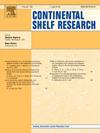Assessment of the sediment budget of the Kara and Laptev seas
IF 2.2
3区 地球科学
Q2 OCEANOGRAPHY
引用次数: 0
Abstract
The rapid acceleration of global warming since the 20th century is expected to significantly influence sediment budget on the Siberian Arctic Shelf. However, comprehensive data on the sediment budget required to assess these changes remain insufficient. In this study, we evaluate sediment mass accumulation rates (MAR) in the extensive coastal Arctic seas, the Kara and Laptev seas, over the past 100 years based on 210Pb dating with the RUS2023 model. Our results showed that MARs in the Gulf of Ob’ and Yenisei Bay are 1.37 and 1.4 g cm−2 yr−1, respectively. MARs in the Novaya Zemlya, Voronin and Sadko troughs are 1.46, 0.82 and 1.99 g cm−2 yr−1, respectively. MARs in the inner and outer Laptev Sea shelf are 1.26 and 0.72 g cm−2 yr−1, respectively. These values are at least ten times higher than previously estimated values obtained using AMS 14C dating over the past few thousand years. The unprecedented increase in the total mass sediment accumulation over the past 100 years may be due to accelerated coastal erosion and soil erosion in the Siberian River catchments, located in the permafrost zone.
喀拉海和拉普捷夫海沉积物收支的评估
预计自20世纪以来全球变暖的迅速加速将显著影响西伯利亚北极陆架的沉积物收支。然而,评估这些变化所需的沉积物收支的综合数据仍然不足。本研究基于RUS2023模式的210Pb测年,评估了近100年来北极广大沿海海域喀拉海和拉普捷夫海沉积物质量积累速率(MAR)。结果表明,Ob '湾和Yenisei湾的MARs分别为1.37和1.4 g cm−2 yr−1。在Novaya Zemlya、Voronin和Sadko槽中,火星分别为1.46、0.82和1.99 g cm−2 yr−1。拉普捷夫海陆架内外的火星含量分别为1.26和0.72 g cm−2 yr−1。这些值比过去几千年利用AMS 14C测年得到的估计值至少高出10倍。在过去的100年里,沉积物总量的空前增加可能是由于位于永久冻土带的西伯利亚河流域的海岸侵蚀和土壤侵蚀加速造成的。
本文章由计算机程序翻译,如有差异,请以英文原文为准。
求助全文
约1分钟内获得全文
求助全文
来源期刊

Continental Shelf Research
地学-海洋学
CiteScore
4.30
自引率
4.30%
发文量
136
审稿时长
6.1 months
期刊介绍:
Continental Shelf Research publishes articles dealing with the biological, chemical, geological and physical oceanography of the shallow marine environment, from coastal and estuarine waters out to the shelf break. The continental shelf is a critical environment within the land-ocean continuum, and many processes, functions and problems in the continental shelf are driven by terrestrial inputs transported through the rivers and estuaries to the coastal and continental shelf areas. Manuscripts that deal with these topics must make a clear link to the continental shelf. Examples of research areas include:
Physical sedimentology and geomorphology
Geochemistry of the coastal ocean (inorganic and organic)
Marine environment and anthropogenic effects
Interaction of physical dynamics with natural and manmade shoreline features
Benthic, phytoplankton and zooplankton ecology
Coastal water and sediment quality, and ecosystem health
Benthic-pelagic coupling (physical and biogeochemical)
Interactions between physical dynamics (waves, currents, mixing, etc.) and biogeochemical cycles
Estuarine, coastal and shelf sea modelling and process studies.
 求助内容:
求助内容: 应助结果提醒方式:
应助结果提醒方式:


